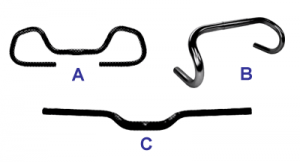The steering system of a bicycle consists of the fork, headset, stem, handlebars, and handlebar grips.
A significant amount of rider comfort (or discomfort) is associated with the steering system setup. Given the amount of time you are going to be on the bike, the right ergonomic setup for the steering system can help you avoid numb hands and sore/stiff shoulders, back and neck.
Consider how you would like to be positioned on the bike for hours at a time. Can you realistically maintain a streamlined, aerodynamic racing position like they do in the Tour de France? or would you be more comfortable with a more upright position?
A more upright position also provides you with the best view of what’s going on around you. You’ll be able to enjoy the scenery, and importantly, be able to easily view and assess hazards (like potholes, animals, and other vehicles on the road).
Choosing Components
Fork – The extension of the frame that attaches to the front wheel. The fork needs to be compatible with the frame so that the front wheel is at the right height, and be compatible with the braking system you have selected. You may also wish to install a front fork with shock absorbers – as previously discussed, shocks do provide a smoother ride over rough ground, but bleed momentum from every pedal stroke. They also add an additional level of complexity to the mechanical maintenance of your bike, so make sure you are prepared to service them if required.
Headset – The bearing system that ensures smooth movement of the fork and front wheel. The headset needs to be compatible with the frame and fork. Broadly speaking there are two types of headset: threaded and integrated. A threaded headset is installed on a fork with a threaded steering column, an integrated headset is installed where there are no threads on the steering column. There are plenty of headset configurations to choose from, so think about the durability of the setup, and if you want to to be able to maintain the system during your ride.
Handlebars & Grips – the interface between the rider and the steering system. There are almost as many opinions on the right handlebar setup for a touring bike as there are grains of sand in the Sahara. It is entirely a personal decision based on what you are most comfortable with. Generally, multiple hand positions during a long day on the road are helpful for limiting numbness and muscle stiffness. The handlebars must be compatible with the brake and gear levers you have selected. If you wish to use a handlebar bag, make sure you have the correct attachments to install it on the handlebar you have selected.
See the great article by Sheldon Brown on choosing the right handlebar setup for you.
